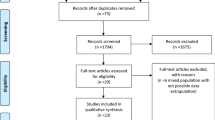Abstract
Background
Feed intolerance is a common problem in neonates with congenital duodenal obstruction (CDO). Some surgeons insert trans-anastomotic tubes (TAT) to facilitate feed tolerance. We conducted a systematic review to evaluate the efficacy and safety of TATs in CDO.
Methods
Medline, EmBase, CINAHL, and Cochrane Library were searched till July 2020. Risk of bias was assessed using ROBINS-I tool. Meta-analysis was conducted using Random Effects Model.
Results
No randomized controlled trials addressing the question were identified. In the 6 included observational studies, 96 infants underwent intraoperative TAT placement and 117 did not. Four studies reported benefits of TAT such as early attainment of full feeds and decreased need for parenteral nutrition. Two studies reported better outcomes in the no-TAT group. Accidental removal of TAT without clinical harm was reported in three studies [5/37 (14%), 4/17 (23%), and 2/4 (50%)]. Overall meta-analysis found no differences between the groups on any outcome. However, sensitivity analysis after excluding two studies with high risk of bias found that TAT tubes are associated with shorter duration of PN and shorter time to full enteral feeds. GRADE of evidence was very low for all outcomes.
Conclusions
Evidence is limited regarding the efficacy and safety of intraoperative TAT placement in neonates with CDO. Well-designed RCTs are needed to address the issue definitively.











Similar content being viewed by others
References
Gfroerer S, Theilen TM, Fiegel HC, Esmaeili A, Rolle U (2019) Comparison of outcomes between complete and incomplete congenital duodenal obstruction. World J Gastroenterol 25(28):3787–3797. https://doi.org/10.3748/wjg.v25.i28.3787
Escobar MA, Ladd AP, Grosfeld JL, West KW, Rescorla FJ, Scherer LR 3rd et al (2004) Duodenal atresia and stenosis: long-term follow-up over 30 years. J Pediatr Surg 39(6):867–871. https://doi.org/10.1016/j.jpedsurg.2004.02.025 (discussion -71)
Bairdain S, Yu DC, Lien C, Khan FA, Pathak B, Grabowski MJ et al (2014) A modern cohort of duodenal obstruction patients: predictors of delayed transition to full enteral nutrition. J Nutr Metab 2014:850820. https://doi.org/10.1155/2014/850820
Bishay M, Lakshminarayanan B, Arnaud A, Garriboli M, Cross KM, Curry JI et al (2013) The role of parenteral nutrition following surgery for duodenal atresia or stenosis. Pediatr Surg Int 29(2):191–195. https://doi.org/10.1007/s00383-012-3200-9
Takahashi A, Tomomasa T, Suzuki N, Kuroiwa M, Ikeda H, Morikawa A et al (1997) The relationship between disturbed transit and dilated bowel, and manometric findings of dilated bowel in patients with duodenal atresia and stenosis. J Pediatr Surg 32(8):1157–1160. https://doi.org/10.1016/s0022-3468(97)90674-6
McCann C, Cullis PS, McCabe AJ, Munro FD (2019) Major complications of jejunal feeding in children. J Pediatr Surg 54(2):258–262. https://doi.org/10.1016/j.jpedsurg.2018.10.078
Sterne JA, Hernán MA, Reeves BC, Savović J, Berkman ND, Viswanathan M et al (2016) ROBINS-I: a tool for assessing risk of bias in non-randomised studies of interventions. BMJ 355:i4919. https://doi.org/10.1136/bmj.i4919
Wan X, Wang W, Liu J, Tong T (2014) Estimating the sample mean and standard deviation from the sample size, median, range and/or interquartile range. BMC Med Res Methodol 14:135
Liberati A, Altman DG, Tetzlaff J, Mulrow C, Gøtzsche PC, Ioannidis JP et al (2009) The PRISMA statement for reporting systematic reviews and meta-analyses of studies that evaluate health care interventions: explanation and elaboration. Ann Intern Med 151(4):W65-94. https://doi.org/10.7326/0003-4819-151-4-200908180-00136
Stroup DF, Berlin JA, Morton SC, Olkin I, Williamson GD, Rennie D et al (2000) Meta-analysis of observational studies in epidemiology: a proposal for reporting. Meta-analysis Of Observational Studies in Epidemiology (MOOSE) group. JAMA 283(15):2008–2012. https://doi.org/10.1001/jama.283.15.2008
Arnbjörnsson E, Larsson M, Finkel Y, Karpe B (2002) Transanastomotic feeding tube after an operation for duodenal atresia. Eur J Pediatr Surg 12(3):159–162. https://doi.org/10.1055/s-2002-32727
Hall NJ, Drewett M, Wheeler RA, Griffiths DM, Kitteringham LJ, Burge DM (2011) Trans-anastomotic tubes reduce the need for central venous access and parenteral nutrition in infants with congenital duodenal obstruction. Pediatr Surg Int 27(8):851–855. https://doi.org/10.1007/s00383-011-2896-2
Mooney D, Lewis JE, Connors RH, Weber TR (1987) Newborn duodenal atresia: an improving outlook. Am J Surg 153(4):347–349. https://doi.org/10.1016/0002-9610(87)90574-5
Upadhyay V, Sakalkale R, Parashar K, Mitra SK, Buick RG, Gornall P et al (1996) Duodenal atresia: a comparison of three modes of treatment. Eur J Pediatr Surg 6(2):75–77. https://doi.org/10.1055/s-2008-1066475
Ruangtrakool R, Mungnirandr A, Laohapensang M, Sathornkich C (2001) Surgical treatment for congenital duodenal obstruction. J Med Assoc Thailand Chotmaihet thangphaet 84(6):842–849
Harwood R, Horwood F, Tafilaj V, Craigie RJ (2019) Transanastomotic tubes reduce the cost of nutritional support in neonates with congenital duodenal obstruction. Pediatr Surg Int 35(4):457–461. https://doi.org/10.1007/s00383-018-4411-5
Shaw D, Gohil K, Basson MD (2012) Intestinal mucosal atrophy and adaptation. World J Gastroenterol 18(44):6357–6375. https://doi.org/10.3748/wjg.v18.i44.6357
Dama M, Rao U, Gollow I, Bulsara M, Rao S (2017) Early commencement of enteral feeds in gastroschisis: a systematic review of literature. Eur J Pediatr Surg 27(6):503–515. https://doi.org/10.1055/s-0037-1598086
Ekingen G, Ceran C, Guvenc BH, Tuzlaci A, Kahraman H (2005) Early enteral feeding in newborn surgical patients. Nutrition 21(2):142–146. https://doi.org/10.1016/j.nut.2004.10.003
Amanollahi O, Azizi B (2013) The comparative study of the outcomes of early and late oral feeding in intestinal anastomosis surgeries in children. Afr J Paediatr Surg AJPS 10(2):74–77. https://doi.org/10.4103/0189-6725.115025
Acknowledgements
We would like to thank Dr. Sanchita Gera and Dr. Ravindra Sahadev for their contributions.
Financial disclosures
The authors report no proprietary or commercial interest in any product mentioned or concept discussed in this article.
Funding
This research did not receive any specific grant from funding agencies in the public, commercial, or not-for-profit sectors.
Author information
Authors and Affiliations
Corresponding author
Ethics declarations
Conflicts of interests
The author declare no conflict of interests.
Additional information
Publisher's Note
Springer Nature remains neutral with regard to jurisdictional claims in published maps and institutional affiliations.
Supplementary Information
Below is the link to the electronic supplementary material.
Rights and permissions
About this article
Cite this article
Biradar, N., Gera, P. & Rao, S. Trans-anastomotic tube feeding in the management of congenital duodenal obstruction: a systematic review and meta-analysis. Pediatr Surg Int 37, 1489–1498 (2021). https://doi.org/10.1007/s00383-021-04954-7
Accepted:
Published:
Issue Date:
DOI: https://doi.org/10.1007/s00383-021-04954-7



